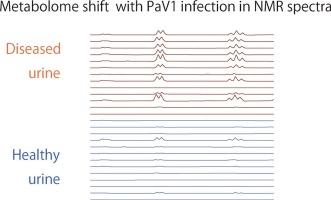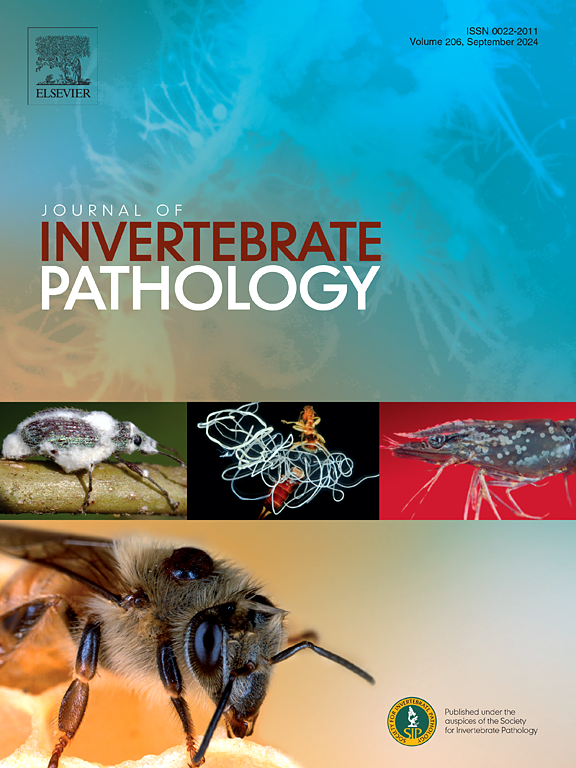黑斑蝶病毒1型(PaV1)感染的气味:加勒比黑斑蝶尿液和血淋巴代谢物的疾病诱导变化
IF 2.4
3区 生物学
Q1 ZOOLOGY
引用次数: 0
摘要
加勒比大龙虾是一种群居物种,它们白天聚集在一起,用尿液中的化学物质作为指引。当动物感染了大腹蛇Panulirus argus virus 1 (PaV1)时,这种行为发生了变化,从而使健康的动物避免接触患病同种动物的尿液。这项研究的目的是确定负责这种聚集行为转换的分子。采集健康动物和患病动物的尿液和血淋巴,结合冷冻探针,利用质子核磁共振(1H NMR)鉴定和定量其代谢物。除尿液外,还检查了血淋巴,因为它可以渗透到患病动物的尿液中,因此可能是疾病特异性线索的来源。采用分形光谱的主成分分析方法,分析了健康动物和患病动物尿液和血淋巴核磁共振谱的总体差异。通过单变量分析确定每个化学移位箱的差异。对健康动物和患病动物的光谱进行全面比较,发现光谱之间存在显著差异。经高效液相色谱(HPLC)分离,采用核磁共振(NMR)和质谱(MS)鉴定了光谱中的主要化合物,包括氨基酸、有机酸、核苷酸、核苷、胺和甜菜碱。通过对比分析,确定了健康动物和患病动物尿液中有6种不同数量的分子:健康动物尿液中的乳酸明显较高,患病动物尿液中的柠檬酸盐、甘氨酸、2′-脱氧腺苷、2′-脱氧胞苷和胸苷较高。早期的研究表明,这些或相关的代谢物是由多刺龙虾或其他海洋甲壳类动物的化学感觉系统感知的。总之,这些发现表明,这六种分子是候选的化学线索,健康的龙虾可能会使用它们来避免患病的同种龙虾,从而避免感染。本文章由计算机程序翻译,如有差异,请以英文原文为准。

The smell of Panulirus argus virus 1 (PaV1) infection: Disease-induced changes in metabolites in urine and hemolymph of Caribbean spiny lobsters Panulirus argus
The Caribbean spiny lobster Panulirus argus is a social species in which individuals aggregate for protection during the day using chemicals in their urine as guiding cues. This behavior changes when animals are infected by Panulirus argus virus 1 (PaV1), such that healthy animals avoid the urine of diseased conspecifics. The aim of this study was to identify the molecules responsible for this switch in aggregation behavior. Urine and hemolymph were collected from healthy and diseased animals, and their metabolites were identified and quantified using proton nuclear magnetic resonance (1H NMR) spectroscopy equipped with cryoprobe. Hemolymph was examined in addition to urine because it can infiltrate the urine of diseased animals and thus might be a source of the disease-specific cues. Overall differences in NMR spectra of urine and hemolymph of healthy and diseased animals were analyzed using principal component analysis of binned spectra. Differences in each chemical shift bins were identified by univariate analysis. Overall comparison of the spectra of healthy and diseased animals showed significant differences broadly across the spectra. Major compounds in the spectra were identified by NMR spectroscopy and mass spectrometry (MS) after high performance liquid chromatography (HPLC) separation as amino acids, organic acids, nucleotides, nucleosides, amines, and betaines. Comparative analysis identified six molecules that differed quantitatively in urine of healthy and diseased animals: lactate was higher in urine of healthy animals, and citrate, homarine, 2′-deoxyadenosine, 2′-deoxycytidine, and thymidine were higher in urine of diseased animals. Earlier studies have demonstrated that these or related metabolites are sensed by the chemosensory systems of spiny lobsters or other marine crustaceans. Together, these findings suggest that these six molecules are candidate chemical cues that healthy lobsters might use to avoid diseased conspecifics and thus infection.
求助全文
通过发布文献求助,成功后即可免费获取论文全文。
去求助
来源期刊
CiteScore
6.10
自引率
5.90%
发文量
94
审稿时长
1 months
期刊介绍:
The Journal of Invertebrate Pathology presents original research articles and notes on the induction and pathogenesis of diseases of invertebrates, including the suppression of diseases in beneficial species, and the use of diseases in controlling undesirable species. In addition, the journal publishes the results of physiological, morphological, genetic, immunological and ecological studies as related to the etiologic agents of diseases of invertebrates.
The Journal of Invertebrate Pathology is the adopted journal of the Society for Invertebrate Pathology, and is available to SIP members at a special reduced price.

 求助内容:
求助内容: 应助结果提醒方式:
应助结果提醒方式:


